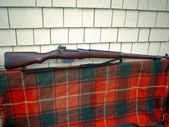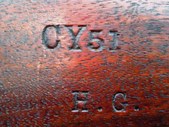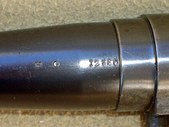-
 Ross HG (Home Guard) MKIII Rifle
Ross HG (Home Guard) MKIII Rifle
Ross HG (Home Guard) MKIII Rifle
"County of York 51st Rifle"
 (Click PIC to Enlarge)
(Click PIC to Enlarge)
 (Click PIC to Enlarge)
(Click PIC to Enlarge)
Caliber: ....................... .303 in., Mk VII Ammo
Rifling & Twist: ............. 4 Groove, Enfield, Left Hand Twist
Barrel Length: .............. 30.5 in. (775mm)
Overall Length: ............ 50.5 in. (1283mm)
Overall Length: ............ 60.5 in. (1537mm) with bayonet attached
Weight: ....................... 8.6 lbs. (3.9kg)
Magazine Capacity: ...... 5 rounds, loaded with chargers
FRT #: ......................... 2126-1
Note: .......................... Mfg primarily 1914-1917, some assembled parts into 1918
Source: ....................... The Ross Rifle Story - ISBN: 0-9732416-0-8
Canadian Market Value Estimate: $
Ross HG (Home Guard) MKIII Rifle
 (58 picture virtual tour)
(58 picture virtual tour)
Observations: (by "Claven2")
Note: Pics of actual MKL rifle provided courtesy of MILSURPS.COM member Longbranch*.
rifle provided courtesy of MILSURPS.COM member Longbranch*.
During the Second Boer War, Canada lobbied the British Government to license Canadian production of the Short Magazine Lee-Enfield Mk1, a new pattern of the Lee-Enfield that was then being developed to address shortcomings identified in the Magazine Lee Enfield ("long lee") - the British refused. About the same time, Sir Charles Ross, a Scottish nobleman and inventor, offered a new straight-pull rifle as a replacement infantry arm for Canadian service. Ross was able to exert much personal influence upon Canadian politicians and officials, eventually landing his first contract in 1903 for 12,000 Mark I Ross rifles.
Government to license Canadian production of the Short Magazine Lee-Enfield Mk1, a new pattern of the Lee-Enfield that was then being developed to address shortcomings identified in the Magazine Lee Enfield ("long lee") - the British refused. About the same time, Sir Charles Ross, a Scottish nobleman and inventor, offered a new straight-pull rifle as a replacement infantry arm for Canadian service. Ross was able to exert much personal influence upon Canadian politicians and officials, eventually landing his first contract in 1903 for 12,000 Mark I Ross rifles.
Ross' design was revolutionary at the time. The rifle's bolt was conceived with an internal screw mechanism that automatically rotated the locking surfaces of the bolt head in and out of battery as the handle was manipulated back and forth linearly. In theory, straight-pull guns could be operated faster than turn-bolt rifles with a greater economy of movement on the part of the soldier, allowing them to remain better concealed when firing from the prone position. The design was also heralded as being inherently accurate compared to many contemporary turn-bolt designs. Additionally, the Ross was lighter than the Lee-Enfield and could be disassembled without the need for special tools.
Being a new design, the Ross Rifle was not without early growing pains. The first 1,000 rifles to be produced and procured were given to the Royal Canadian Mounted Police (RCMP) for field testing. Inspection of the rifles found 113 defects bad enough to warrant rejection by the Government, including a poorly designed bolt lock that sometimes caused the bolt to fall out of the rifle. The poor quality of the springs being used were also cause for great concern. In 1906, the RCMP handed in their Ross rifles in favor of returning to reliable Lee Metfords and lever-action carbines they had used previously.
Subsequent to the somewhat disappointing experience the RCMP had with the Ross, the rifle underwent a series of modifications to address any newly-highlighted deficiencies in the design. The result was the Mark II Ross (Model 1905). Prior to the First World War, the Commonwealth Forces had been experimenting with smaller-diameter high-velocity cartridges, usually rimless or semi-rimless, one of which was the high-pressure .280 Ross. In 1907, the Mk II was modified to withstand the increased pressure generated by the .280 Ross - the variant being called the Ross Mk II** - though no .280 Ross chambered rifles were adopted and issued for military service.
Further experience, and the resultant development to address design faults, led to the Ross Model 1910 (Ross MkIII). It was a completely new design with a much-changed locking mechanism and single-stack magazine that protruded from the stock. As a result, there is virtually no parts interchangeability between the Ross Model 1905 and the Ross Model 1910.
In all, approximately 420,000 Ross service rifles were produced, 342,040 of which were purchased by the British.
The Ross Model 1910 was the standard infantry rifle on issue to the First Canadian Contingent of the Canadian Expeditionary Force when it arrived in France in February 1915, Canada having automatically entered WW1 alongside Great Britain on August 4, 1914. Sadly, the Canadian experience of the Ross Rifle in the trenches would forever thereafter be remembered in infamy.
in February 1915, Canada having automatically entered WW1 alongside Great Britain on August 4, 1914. Sadly, the Canadian experience of the Ross Rifle in the trenches would forever thereafter be remembered in infamy.
The first serious problems with the rifle became apparent during the Second Battle of Ypres in April 1915. Unlike the Short Magazine Lee Enfield (SMLE) MkIII being used by British forces, the Ross proved to have a very poor tolerance of dirt and grit, the screw threads operating the bolt lugs would then jam the weapon open or closed in the heat of battle. The propensity to jam was exacerbated because the bolt's outer face could hit the bolt stop and deform the threads that locked the bolt head. After battles, dead Canadian soldiers could be seen clutching jammed Ross rifles, in some cases the soldiers had tried desperately to clear jams by hitting the bolt handles with their boot heels.
Another problem arose as a result of the very fast pace of training due to the pressures of war. If not properly reassembled after cleaning, the Ross MkIII bolt could remain unlocked and still fire a cartridge. If the rifle were fired from the shoulder under these conditions, the bolt could be violently ejected from the rifle's receiver, often leading to the death or disfigurement of the firer. Just when it seemed the situation could not get much worse, it became apparent that the bayonet had a tendency to dismount from the rifle when it was fired and the blade point had not been designed to sufficiently penetrate the great-coats that German soldiers were in the habit of wearing.
soldiers were in the habit of wearing.
The situation became so bad that many men of the First Contingent (now renamed the First Canadian Division) at Ypres took to salvaging SMLE MkIII rifles from the corpses of British casualties to replace their malfunctioning Ross MkIII rifles. By the time of the Somme battles of July 1916, Sir Douglas Haig, the new Commander-in-Chief of the British Expeditionary Force, had ordered the replacement of all Ross rifles in the three Canadian Divisions by the Lee-Enfield, which was finally available in quantity.
The Canadian Minister of Militia and Defense, SamHughes, did not believe there were problems with the Ross significant enough to warrant its withdrawal from front-line service and it took the advice of many officials and politicians to eventually convince him otherwise. In November 1916, Hughes resigned - probably in large part over the growing scandal surrounding the issue of the Ross MkIII. After that time, Ross rifles were generally relegated to training roles, both in Canada and the UK, to free up much-needed SMLE rifles for front-line service. Ross rifles were also shipped to the U.S. in 1917 for training purposes, allowing re-distribution of available M1903 Springfield rifles.
Perhaps due to its legendary long range accuracy, the Ross rifle continued in use among Allied snipers well after it was withdrawn from front-line use. The Ross apparently performed well in this role, provided that specially-selected, clean ammunition was used.
Apart from the rather bad account the Ross Rifle was giving of itself in Europe, the rifle was still well-regarded at the rifle range and in climates where mud, dirt and grit infiltration were of less concern. While the threat of invasion in North America was largely imaginary, Home Guard units were organized and trained to counteract this perceived threat. Among other arms, a small quantity of Ross MkIII rifles was procured for home-guard units. Though serial number records are non-existant, observation of known rifles places the number of Home Guard rifles produced at about 1,000. Unlike the rifles issued to the Canadian Forces, Home-guard rifles were serial numbered on the barrel and were stamped "H.G." on the butt in place of the Quebec Roundel and model markings more typically encountered.
Unit markings are generally also present on Home Guard issued Ross Rifles, the above example having been rifle number 51 in service with the County of York Home Guard unit. The pristine condition of this rifle speaks to its history of only incidental use.
Collector's Comments and Feedback:
1. The following is an extract from "The Ross Rifle Story" on Home Guard MKIII's:
"Issued to the Home Guard. Although these were issued to quasi-military units, the rifles do not have military issue marks on the butt.Instead, they have H.G.B.of M., or H.G.21(name or number of unit) on the butt only. On the left side of the breech, a rifle serial number is stamped ie:HG 16977. The number of Home Guard rifles produced probably numbers 1,000. 260 are known to have been delivered by the dominion Rifle Co. after expropriation of the Ross Rifle Co. Serial numbers of rifles fall into two clusters,12,125-12,611 and 13,863-17,977. One such rifle seen has the year of issue, 1915, on the butt". ...... (Feedback by Geoff "Longbranch*" McGuire)
2. I don't know about the HG rifles from the Dominion Rifle Factory, but the earlier HG rifles exhibit all the features of early production Mk. III rifles. Small aperture in rear sight, small bolt stop, sling swivel in front of trigger guard, unaltered chamber, etc. Issue Mk. III rifles would likely have been altered during their period of service, with chambers enlarged, bolt stops replaced, aperture opened out.
I simply do not know how common it was for bolts to be launched from rifles. It certainly happened, but whether it was common or not, I do not know. If a bolt was blown open, the extent of injuries to the shooter tended to depend on how the rifle was being held. The bolt generally will not pass the bolt stop. If the shooter was standing, in an erect position, the bolt might not strike him. If the rifle was snuggled in, the injury could be horrific.
Jamming problems were not universal; some veterans reported that a lack of reliability was not a factor. Careful maintenance was certainly a consideration.
Incidentally, my HG rifle is butt marked HG100. It is in near new condition. There are no brass smears on the feed ramp, or in the magazine, and no primer ring on the boltface. ...... (Feedback by tiriaq)
3. This is likely the finest Home Guard Ross to come on the market for a few years now- never been messed with! The Home Guards were produced to commercial tolerances, not sloppy military ones. Total production is believed to be less than 1,000 rifles, and most that have turned up were found either unfired or very lightly used. ...... (Feedback by Rossguy)
4. I would like to add the following comments.
A figure of 342,040 Ross rifles is quoted as being purchasd by the British. I belive this figure is inaccurate. Here is the actual breakdown.
- Ross Mk111B rifles orderd by British Government, 100,000. Actually delivered; 66,591.
- Taken over from the Canadian Government in exchange for SMLE's 95,674.
- Purchased by the Admiralty, from the USA in 1915 - model not known for sure- 750.
in 1915 - model not known for sure- 750.
- Purchased from Canada by Britain in 1940 for British Home Guard use, 75,000.
The total is therefore ( if we included the 95,674 exchanged Ross rifles), 238,015.
...... (Feedback by Alan "AlanD" David, Sydney Australia )
)
Information
 |
Warning: This is a relatively older thread
This discussion is older than 360 days. Some information contained in it may no longer be current. |
|
Last edited by Badger; 11-16-2010 at 09:43 AM.
-
Thank You to Badger For This Useful Post:
-
09-20-2009 04:36 PM
# ADS
Friends and Sponsors

(Click PIC to Enlarge)
(Click PIC to Enlarge)
rifle provided courtesy of MILSURPS.COM member Longbranch*.
Government to license Canadian production of the Short Magazine Lee-Enfield Mk1, a new pattern of the Lee-Enfield that was then being developed to address shortcomings identified in the Magazine Lee Enfield ("long lee") - the British refused. About the same time, Sir Charles Ross, a Scottish nobleman and inventor, offered a new straight-pull rifle as a replacement infantry arm for Canadian service. Ross was able to exert much personal influence upon Canadian politicians and officials, eventually landing his first contract in 1903 for 12,000 Mark I Ross rifles.
in February 1915, Canada having automatically entered WW1 alongside Great Britain on August 4, 1914. Sadly, the Canadian experience of the Ross Rifle in the trenches would forever thereafter be remembered in infamy.
soldiers were in the habit of wearing.
in 1915 - model not known for sure- 750.
)
Information


















 PM
PM






